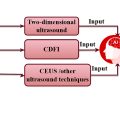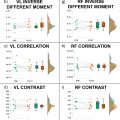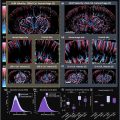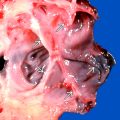ABSTRACT
Objective
This study aimed to validate the ultrasound speckle tracking (UST) algorithm, determine the optimal probe location by comparing normalized cross-correlation (NCC) values of muscle displacement at two locations (proximal vs. middle) of the biceps femoris long head (BFlh) using the UST, and investigate the effects of Nordic hamstring curl exercise (NHE) training on BFlh displacement.
Methods
UST efficacy was verified with ex vivo uniaxial testing of porcine leg muscles. Ten participants (mean age 23.4 y) were recruited for comparison of NCC values between the proximal and middle BFlh during maximal knee flexor eccentric contraction using an ultrasound device and isokinetic dynamometer. Using the above devices, electromyography and shear wave elastography, the effects of an 8-wk NHE program on the morphomechanical profiles, displacement and activation of the middle BFlh and eccentric torque of the knee flexor were investigated in 20 males (mean age 23.5 y).
Results
The validity of UST was confirmed by comparing UST and ex vivo test results ( r = 0.99). The NCC values of the middle BFlh were greater than those of the proximal BFlh. The caudal-direction displacements of the BFlh in the dominant leg were reduced after the NHE training (from 3.98 ± 3.84 to 1.50 ± 4.17 mm, p < 0.05). The magnitude of reduction was associated with improved eccentric strength of the knee flexor muscle in the dominant leg ( r = 0.63).
Conclusions
UST is a validated tool for measuring muscle displacement. NHE training decreased caudal-direction muscle displacement in the BFlh and increased eccentric strength.
Introduction
Hamstring strain injuries (HSI) are among the most common injuries in sports involving high-speed running or extreme stretching of the hamstring muscles [ ]. The mechanism of HSI is related to excessive strain (deformation in length) in the musculature at the proximal myotendinous junction of the long head of the biceps femoris (BFlh) [ , ]. Previous studies have focused on quasi-isometric of the BFlh fascicle during eccentric tests of knee flexors [ , ] and fascicle length to clarify HSI mechanisms [ ]. Due to the decoupling of the muscle fascicle and muscle–tendon unit behaviors [ ], whether there is an elongated/elongating strain ( i.e. , positive strain) in the proximal BFlh during eccentric contractions is inconclusive. In addition, whether the strain in the proximal BFlh is reduced after interventional training remains unresolved. Preventive exercises for hamstring injury include Nordic hamstring curl exercise (NHE) and isometric exercise training [ , ]. NHE training leads to increases in muscle elasticity [ ], fascicle angle, and BFlh length [ , ] and knee flexor eccentric torque [ ]. It is suggested that training to strengthen hamstring muscles and increase the eccentric contraction force of knee flexion results in higher absorption of elastic energy prior to muscle–tendon failure [ ]. Therefore, eccentric force and strain in the proximal BFlh following NHE training may be associated, as both are products of the summed effects of muscle adaptations.
Ultrasound speckle tracking (UST) can be used to calculate the regional displacement of loaded muscle [ , ] and assess the training effects of the exercise intervention [ ]. While UST has been used to study the supraspinatus, biceps and neck muscles [ , ], further validation of the algorithm is necessary. Furthermore, studies that observe muscle displacements must report the normalized cross-correlation (NCC) values when using NCC-based speckle-tracking algorithms to measure similarity in the image registration process [ ]. The NCC value is a variable used to evaluate the accuracy of UST estimations [ , ]. Therefore, it is crucial to validate the algorithm and determine the probe location for measuring BFlh displacement with high NCC values.
Since muscle fascicles mainly contract quasi-isometrically during eccentric contractions [ ], we inferred that the displacement of the BFlh toward the insertion of the muscle can be used to estimate the deformation (elongation strains) at the proximal BFlh during dynamic eccentric tests while disregarding changes of muscle length. This study aimed to use UST to measure the displacement of the BFlh muscle and to investigate the effects of an exercise intervention on this displacement. This study consisted of three parts. The first part validated the speckle-tracking algorithms with an ex vivo experiment with porcine leg muscles by comparing the results of UST using beamformed radiofrequency data and those of a material testing system (MTS). In the second part, we sought an optimal probe location for the third part of this study by comparing the NCC values required to estimate BFlh displacement at two muscle locations (proximal vs. middle) during maximal eccentric contraction. We also evaluated the reliability of measurements of muscle displacement at these locations during contraction. Since ultrasonography measurements of fascicle length and fascicle angle in the middle BFlh demonstrated greater intra-rater reliability, compared to the measurements of the proximal and distal parts [ ], we hypothesized that the NCC acquired from the middle BFlh was greater than that obtained from the proximal part. The third part evaluated the effects of 8 wk of NHE training on muscle displacement in healthy participants. In addition, we evaluated morphomechanical characteristics, activation of the BFlh and knee flexion strength as secondary outcomes that could demonstrate the effects of NHE training. Our primary hypothesis was that the NHE training reduced the caudal–cephalic direction of muscle displacement in the BFlh in both the dominant and the non-dominant leg. The data for the dominant and non-dominant legs were not pooled for analyses due to evidence showing variation in the training effects of NHE on the legs [ ]. In addition, we hypothesized that the changes in magnitude of muscle displacement were associated with improvements in the eccentric strength of knee flexor muscles in either leg.
Materials and methods
General statement and participants
This study was approved by the institutional review board of National Taiwan University Hospital (Reference No. 202207210RIND) and was conducted in accordance with the ethical standards based on the 1964 Declaration of Helsinki. All participants provided written informed consent, and the rights of the participants were protected. The inclusion criteria were healthy male college students or staff between the ages of 20 and 40 y who regularly performed moderate- to vigorous-intensity exercise for at least 150 min weekly. The exclusion criteria included [ ] any known systemic diseases or potential risks that may cause changes in soft tissue composition and mechanical properties, such as lower extremity surgery, ankylosing spondylitis, rheumatoid arthritis and diabetes; [ ] HSI in the past 2 y or any other lower extremity musculoskeletal injury within the past 6 mo; [ ] inability to extend knees above 20° in the 90–90 straight leg raise test; [ ] a functional assessment scale for acute hamstring injuries score below 96 [ ]; and [ ] compliance rate below 80% in the 8 wk training in the third part of the study.
First part: Validity and ex vivo uniaxial displacement of porcine muscles
This study used a 3D-printed container ( Fig. 1 A) filled with approximately 750 grams of fresh porcine leg muscles. The upper end of the container was secured using the clamp for the crosshead of the MTS (MAX-1KN-M, Japan Instrumentation System Co., Ltd., Japan). An opening on one side of the container allowed for the longitudinal placement of the ultrasound probe, which was secured using a test tube holder. Radiofrequency data were recorded at a frame rate of 60 fps over a selected ROI window sized approximately 200 × 128 (axial × lateral) signal samples ( Fig. 1 B). The radiofrequency data were collected during the tests, exported as binary files, and imported into Matlab (The MathWorks, Inc., Natick, Massachusetts, USA) for further offline analysis. The NCC-based speckle-tracking algorithm with the block-matching method was validated by correlating the lateral displacement from UST and crosshead displacement from the MTS.

Second part: In vivo eccentric testing task for human BFlh, tracking quality and reliability
The tracking quality (NCC values) of muscle displacement in the proximal and middle BFlh of the dominant leg was evaluated during knee flexor eccentric contractions in healthy young male participants. We randomly selected which location (proximal or middle) to measure first by flipping a coin. The other location was measured after completing all measurements for the first location. For conducting the above tests, the participant lay prone on the table of an electromyography (EMG)-integrated dynamometer system (System 4 Pro, Biodex Corporation, NY, USA; Fig. 2 ). Straps were used to stabilize the trunk, thigh and leg, ensuring proper positioning of the knee at 90° flexion. The dynamometer’s mechanical axis of rotation was aligned with the lateral condyle of the knee. The eccentric tests, the starting and endpoint positions were 90° and 0° of knee flexion (full knee extension) at an angular velocity of 20°/s ( Fig. 2 ). The angular velocity of UST was chosen based on our pilot work because it was slow enough to collect radiofrequency data with satisfactory NCC (>0.75) and the test period was within the maximum capacity of computer data collection. The instruction for the tests was to move “against the resistance as fast and hard as possible through the eccentric test range.”

T ¯
and <SPAN role=presentation tabIndex=0 id=MathJax-Element-2-Frame class=MathJax style="POSITION: relative" data-mathml='I¯’>?⎯⎯I¯
I ¯
are the mean value of block in previous frame and candidate blocks in the next frame respectively. NCC values range from 0 to 1, where 0 indicates a subpar match and 1 represents the best match.
A customized ultrasound system (T-3300RF, BenQ Medical, Taipei, Taiwan) with a 4–15 MHz broadband linear probe (L154BH_T3300, BenQ) was used to acquire beamformed radiofrequency data at 40 MHz. The frame rate (56–70 fps) varied by depth, with an ROI of ∼30 × 120 signal samples (axial × lateral) for UST. The probe was placed on the proximal (just below the level of the gluteal sulcus) and the middle BFlh (midway between the ischial tuberosity and the top of the fibular head) parallel to the muscle fibers. A 3D-printed probe bracket was used to fix the probe on the skin surface to attempt to reduce tissue out-of-plane movement. Medical ultrasound coupling gel was used as the medium for attaching the probe to the skin. In the longitudinal view of the proximal BFlh, the probe was positioned beneath the gluteal fold, where the gluteus maximus was no longer visible, and the underlying sciatic nerve was identified [ ]. The ROI was manually selected based on the anatomical border of the BFlh, which was visualized by converting radiofrequency signals into a grayscale image using the Hilbert transform ( Fig. 2 ). A familiarization session was undertaken with submaximal contractions for the tests. Each test was repeated at least three times to obtain averaged results. There was a 2-min interval between each test. Accumulated muscle displacements were subsequently analyzed offline.
The dynamometer system and the ultrasound devices were synchronized through an offline analysis program custom-designed with Matlab. The onset of eccentric contraction during maximal eccentric testing was defined as the point when the angular displacement exceeded 0.35° on the EMG-integrated dynamometer system. The time of onset for UST in the above tests was defined as the amount of muscle displacement greater than 0.1 mm in either the caudal or the cephalad direction compared to the baseline. UST ended when the knee joint moved from a 90° flexion position to a full extension position. The accumulated displacements in the BFlh in the tests were calculated between the initial and end frames of UST, corresponding to the start and end of the eccentric tests, respectively. We defined the value of displacement in a caudal direction as positive and that in a cephalic direction as negative ( Fig. 3 ).

All participants were invited, but not obligated, to participate in the muscle displacement reliability test. The second UST measurement was conducted 7 d after the initial measurements . The results for 10 participants showed that the NCC values of the middle BFlh (0.80 ± 0.04) were greater than those of the proximal BFlh (0.75 ± 0.04) in both contraction tests ( p < 0.01), with similar reliability of muscle displacement measurements ( Supplementary Table ).
Third part: NHE training and pre- and post-tests
By extending the results of the second part of the study, the third part aimed to evaluate the effects of an 8-wk NHE training (the training protocol is shown in Table 1 ) adapted from a previous study [ ] on the displacement (the same setting as in the second part of the study), morphomechanical characteristics, and muscle activation of the middle BFlh muscle and peak eccentric torque (at an angular velocity of 60°/s) of knee flexion in the dominant and non-dominant legs ( Fig. 3 ). We randomly chose the leg to measure first by tossing a coin. Therefore, the pre- and post-tests started with measurements of the morphological characteristics (fascicle length, pennation angle and muscle thickness), using an SL15-4 linear transducer, of the middle BFlh with methods previously described [ ]. The shear wave speed of the middle BFlh at rest with a prone position was recorded bilaterally using a probe (XC6-1 curved transducer) with an ultrasound device (Supersonic Imaging, Aixplorer, Aix-en-Provence, France). The placement of the XC6-1 probe on the middle BFlh was consistent with UST. While obtaining each elasticity measurement, the ultrasound probe was kept stationary for 10 s during image acquisition. The shear wave speed of the muscles was assessed using a round ROI with a diameter of 14–30 mm. This type of probe has been used to measure the stiffness of the psoas major and quadratus lumborum [ ].
Using the same instrumentation as in the second part of the study, the displacement of the BFlh was measured in the middle BFlh. EMG was assessed during eccentric tests (at an angular velocity of 20°/s) with wireless surface EMG recording electrodes (DTS, myoRESEARCH™3.8.6, Noraxon, Scottsdale, AZ, USA) sampled at 1500 Hz. The EMG unit specifications included an amplifier gain of 2000, hardware bandpass filter of 10–500 Hz, an input impedance of >1 MΩ, and a common-mode rejection ratio of >100 dB. The methods of surface electrode positioning above the muscles and skin have previously been described in the literature [ , ]. The root mean square EMG amplitude was quantified for a 1-s epoch corresponding to the maximum phase during contractions. The participants were then instructed to perform an isometric test, with the body positioned with the knee flexed at 30°. The participants were instructed to ramp contract their hamstring muscles for 3 s and maintain their maximum voluntary isometric contraction of knee flexors for 3 s until the test was completed. The root mean square EMG amplitude was quantified for a 1-s epoch corresponding to the maximum phase for normalization of eccentric muscle activation.
The participants trained twice weekly, with at least 48 h between each training session. The details of performing the NHE have been described previously [ , ]. In brief, during NHE training, the participants were instructed to slowly lean forward without flexing the hip throughout the range of motion and use their hamstrings to resist the falling motion for as long as possible to maximize the load during the eccentric phase.
Statistical analysis
The data are reported as mean ± standard deviation based on the distribution. The Shapiro–Wilk test was used to determine whether the data for all variables were normally distributed. In the first part of the study, in the ex vivo validity test, the Pearson correlation test was applied to determine the association between the lateral displacement from UST and crosshead displacement from the MTS to test the concurrent validity of UST, while the mean absolute error and mean absolute percentage error were calculated to measure the absolute validity of UST. In the second part of the study, the paired t -test or non-parametric Wilcoxon signed-rank test ( p < 0.05) was used to compare NCC values between the proximal and middle BFlh. The test–retest reliability of displacement of the BFlh was analyzed based on the intra-class correlation coefficient [1,3]. In the third part of the study, the effects of the NHE on primary, i.e. , muscle displacement, and secondary outcomes, such as muscle activation and morphomechanical characteristics, were analyzed using 2 × 2 (time [pre- and post-test] × leg [dominant and non-dominant]) repeated measures analysis of variance (ANOVA, p < 0.05) or the non-parametric Friedman test. Then post-hoc testing using the t -test, with Bonferroni correction ( p < 0.012), was used for multiple comparisons when significant interactions were observed to determine whether there were significant differences; the data were normally distributed ( p > 0.05). The Pearson correlation coefficient was used to analyze correlations between changes in the peak torque of knee flexor muscles (post-test minus pre-test) and the changes in the amount of displacement of the middle BFlh before and after training (post-test minus pre-test). All analyses were performed using SPSS 22.0 (SPSS Inc., Chicago, IL, USA).
Results
The results of the ex vivo validity test showed that the lateral displacement from UST was strongly positively correlated with the crosshead displacement from the MTS. The r value was 0.99 ( Fig. 1 C), and the mean absolute error and mean absolute percentage error were 0.80 ± 0.39 mm and 18.6% ± 11.7% respectively. The second and third parts of the study recruited 10 and 20 male participants, respectively, whose dominant leg was their right leg. No potential participants were excluded based on the established exclusion criteria. The participants’ physical characteristics are shown in Table 2 . The second part of the study found that the NCC value of the middle BFlh was 0.80 ± 0.04 and greater than that of the proximal BFlh (0.75 ± 0.04; p = 0.007). These 10 participants also underwent test–retest reliability assessments ( Supplementary Table ). In the third part of the study, two-way ANOVA revealed a significant interaction ( p < 0.05), in which muscle displacement in the caudal-direction during eccentric contractions of the middle BFlh in the dominant leg decreased after 8 wk of the NHE (post-hoc test: p = 0.006; Table 3 ). In the case of secondary outcomes, there were significant time effects, which included bilateral increases in the eccentric torque of knee flexion ( p < 0.001), muscle fascicle length ( p < 0.001) and muscle thickness ( p = 0.04) of the middle BFlh at rest ( Table 3 ). The correlation between the magnitude of change in knee flexor eccentric peak torque and the reduction in caudal-direction muscle displacement during knee flexor eccentric contraction tests in the dominant leg was positive ( r = 0.63, p = 0.01), while the correlation in the non-dominant leg was insignificant ( r = 0.02, p = 0.91).







